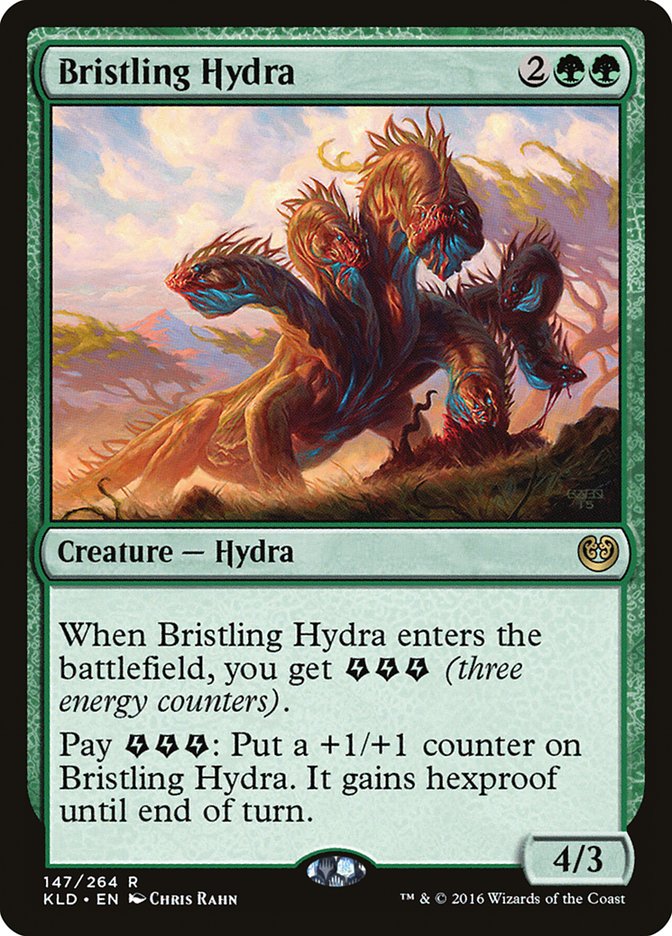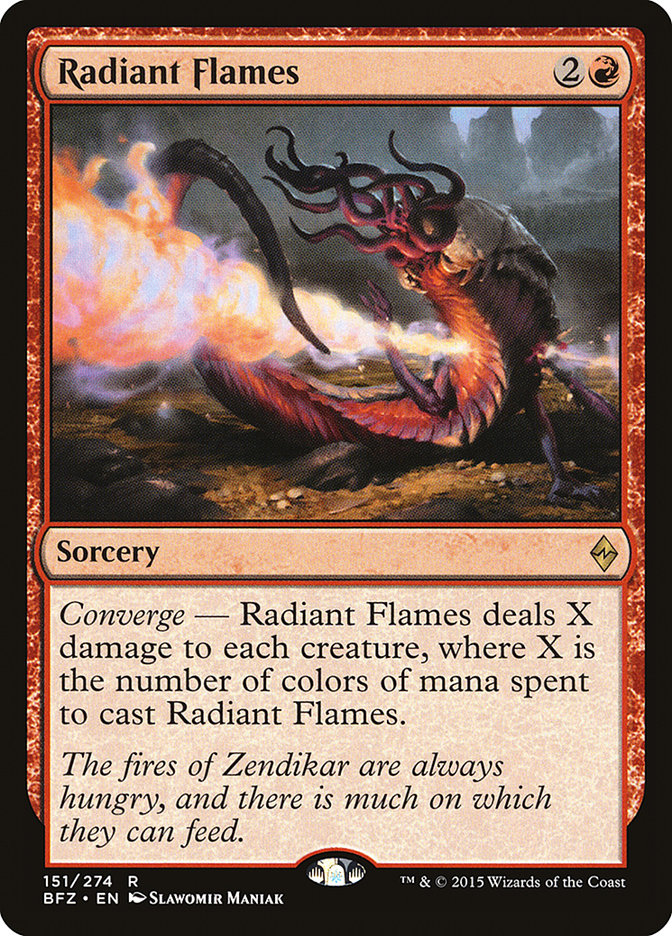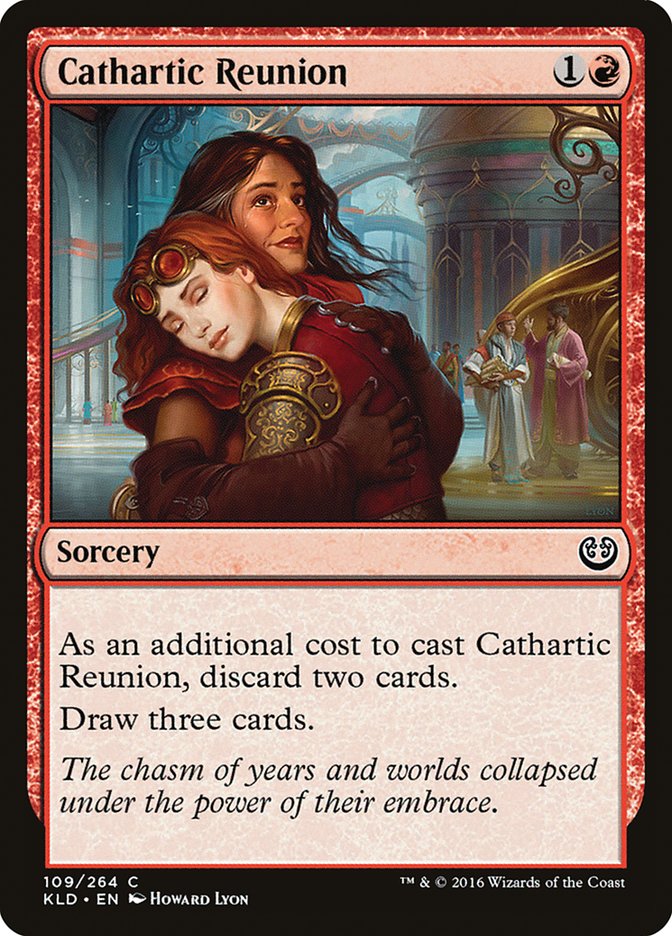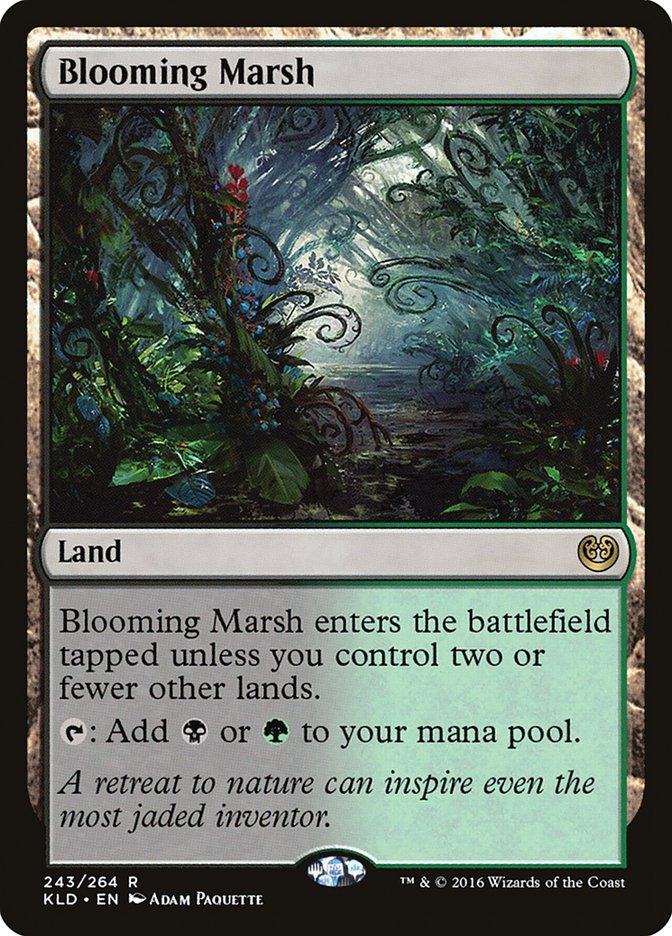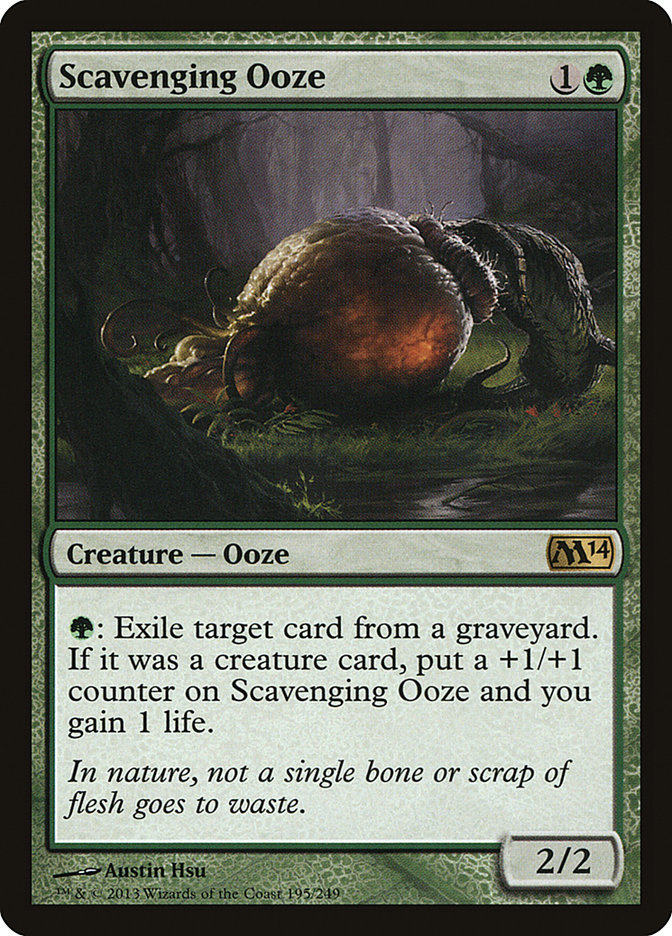With the Pro Tour come and gone, we have a lot more information about Standard at our disposal. While Dynavolt Tower had a good showing at the tournament, most decklists looked very little like what I put together last week. Instead, those piloting Dynavolt Tower went more in the direction of counterspells to fight unfair cards.
Creatures (1)
Lands (24)
Spells (35)

In my article last week, I talked about some cards that were particularly tough to beat unless you had a good draw or were able to wiggle your way out thanks to Thing in the Ice. However, after playing with the deck more at #SCGRegionals this past weekend, my biggest fear came true.
I lost to Bristling Hydra in my win-and-in for Top 8.
Boo.
While I did defeat G/R Energy Aggro two other times during the Swiss, every single game against the deck was an entrenched battle. Trying to find ways to play around Bristling Hydra’s ability was just too difficult at times, and every win against the deck came from flipping Thing in the Ice just in the nick of time. It always felt like an uphill battle that was almost impossible to win if they ever cast Bristling Hydra. And yes, they did. Every game. After all, the U/R Dynavolt deck doesn’t win quickly.
Now, there are some things you can do in order to make your G/R Energy Aggro matchup a bit better. It starts with adding a splash color and probably ends with just playing Shota Yasooka’s Grixis Control list. Regardless of the path you choose, the straight U/R Dynavolt deck I played last week does not have a favorable matchup against a decent number of strategies. In essence, it is a metagame deck, geared toward beating the ever-loving crap out of W/R Vehicles with sideboard cards that can help you overcome tougher matchups.
At the Pro Tour, the talk of the tournament was Aetherworks Marvel. Over 70 (!) players at the Pro Tour brought some form of Aetherworks Marvel, showcasing exactly what the deck could do. However, it seemed to falter against any dedicated control deck featuring counterspells, which isn’t surprising to anyone who’s ever played with or against a glass cannon combo deck. And if you noticed, I didn’t exactly have a lot of counterspells in my U/R Dynavolt deck from last week, and that could be a major problem moving forward.
So what did we learn?
Creatures (6)
Planeswalkers (1)
Lands (26)
Spells (27)

For starters, we learned pretty early on in the weekend that control was going to be a major player. When aggressive decks have cards like Smuggler’s Copter, counterspells like Negate actually gain a ton of value and can even be worked into the maindeck without much trouble. In addition to Negate being good against Vehicles, it also alleviates some of the stress that certain troublesome permanents could play against a control strategy. Gideon, Ally of Zendikar is particularly annoying, both as an indestructible body and the ability to generate multiple threats. One of the last things you want to see is a Gideon, Ally of Zendikar when your hand is full of Harnessed Lightning and Galvanic Bombardment.
Counterspells in general looked pretty good all weekend. Most decks aren’t rushing through the gates, instead relying on powerful mid-game cards like Verdurous Gearhulk or various planeswalkers to increase power level, but that comes with a hard price against decks packing Void Shatter.
And when those decks playing Void Shatter also have the ability to sweep your creatures away in the early turns with Radiant Flames, you’ve got a problem. Overcoming Shota Yasooka’s deck is going to be difficult, no matter what you’re piloting. It has a lot of the right tools to fight the most common things people will throw at it, and counterspells in general solve a lot of the problems a control deck would normally face.
I’ve played about ten matches so far with Shota’s deck, and it is magnificent. It isn’t quite Jeskai Black, but what is, really? And after this weekend, I’m going to focus my time and energy on trying to make it better in the coming weeks. For now, I think we should move on to Modern in preparation for #SCGMKE.
Modern with Kaladesh
We’ve only had a small taste of Kaladesh in the Modern format with the Modern Classic at #SCGINDY. And in a turn of events that surprised exactly no one, Brad Carpenter took down the tournament with a new take on Infect, featuring Blossoming Defense.
Creatures (12)
Lands (20)
Spells (28)
- 4 Might of Old Krosa
- 1 Spell Pierce
- 4 Vines of Vastwood
- 2 Distortion Strike
- 1 Twisted Image
- 4 Mutagenic Growth
- 4 Gitaxian Probe
- 1 Dismember
- 4 Become Immense
- 3 Blossoming Defense
Sideboard

Now, Tom Ross and I played the Jund VS. Infect matchup on the VS Series earlier this week. If you want to know how that matchup plays out, you should check it out. No spoilers here.
But what I did notice in our games is that having extra ways to protect your creatures was particularly annoying for a deck that was traditionally favored in the matchup. Jund, with all its discard and removal, as well as cheap threats to apply pressure, usually has an advantage against Infect. It can be tough to string together a win against a deck hitting you from multiple angles, but Infect always seems to find a way.
If you’ve played against Infect before, you know the drill. You kill the first creature or two and ultimately die to an Inkmoth Nexus or Blighted Agent after the dust settles. Become Immense has given the deck a swingy card that usually ends the game on the spot. By taking into consideration the sheer power of Become Immense, you realize that it doesn’t take a flurry of pump spells to get the job done. That means you can dedicate more slots in your deck to protection spells to keep your creatures alive.
I gotta say, Blossoming Defense looks impressive.
In a pinch, it can be used to kill an opposing blocker in combat, but its main job is keeping your Infect creatures alive. And, if your point of pressure is Inkmoth Nexus, your opponent will often be forced to try to kill it while you’re attacking. This makes the pump effect from Blossoming Defense that much better. Coupled with Noble Hierarch, Pendelhaven, or Mutagenic Growth, a single pump effect from Blossoming Defense could be all you need to get the job done.
Will Blossoming Defense overtake Vines of Vastwood as the primary protection spell of choice? Well, if I had to guess, I’d say the answer is a resounding “yes.” Honestly, I hate Vines of Vastwood. It almost feels like a relic of a time passed, since there are no more Splinter Twins running around to give it additional value. Using the Kicker on Vines of Vastwood is rare, though it does help you on occasion. I’m not advocating that you cut Vines of Vastwood, but only that you realize that Blossoming Defense is probably better.
This is a card that I haven’t really liked in Infect…basically ever. I always try to play Rancor or Apostle’s Blessing before I play with Distortion Strike, but I’m not exactly sure why. In the matchups where Distortion Strike is good, it usually wins you the game. But in matchups like Jund, Grixis, or Jeskai, it is often a dead card, and I truly hate having dead cards in Modern. But I think that’s where the deck needs to go.
With so many protection spells, Become Immense is much better than ever before. And since we need to lean toward Blossoming Defense and Vines of Vastwood as those protection spells, we really need a way to help Glistener Elf get the job done. Against decks with potential blockers, Glistener Elf can be one of the worst cards in your deck. But when paired with Distortion Strike, it will occasionally kill your opponent on the spot (or perhaps over two attacks).
Most importantly for Infect, you are naturally favored against most of the non-interactive decks in Modern. When people are trying to be degenerate, Infect can play with the best of them. The goldfish rate of Infect is hard to top, and it is consistent to boot. Many decks that would normally give Infect a run for its money tend to be high-variance and often have draws that can’t scrape together a win. That is the one reason why I’ve had Infect as a potential Modern option for the past year and change.
Infect tends to falter against hyper-interaction. And by that I mean it struggles against decks that attack its creatures relentlessly while also building toward some other plan of attack. Jeskai Control, for example, is a very tough matchup for Infect. Fighting through all that removal and card advantage can be tiresome and sometimes downright impossible. Jund and Grixis are on a similar wavelength here, as all three decks are stuffed to the gills with removal. As the Infect player, if you’re never able to stick a threat, you can’t really expect to win.
Throughout Magic’s history, decks that rely on synergy are often overpowered by brute-force redundancy. It just has to be the right kind of redundant interaction. While Blossoming Defense could potentially be the game-changer that Infect needed to compete with these hyper-interactive decks, I’m skeptical.
Next up, the bogeyman.
Creatures (24)
Lands (20)
Spells (16)

Before we go any further, I wanted to point out that Ross Merriam wrote a fine article on Dredge earlier this week, and you should definitely read it if this is the deck you want to play this weekend. The main point of contention between our lists (which are nearly identical) is the manabase. I’m currently in the Tom Ross camp: you want your early Life from the Loam to help you hit your land drops. At the expense of a single matchup, Burn, Ross wants to change the manabase. It isn’t something I can really explain, but my gut is telling me that the fetchland manabase is the way to go.
Now, I really want to put an emphasis on this card.
I can’t stress how powerful this type of effect is in Dredge. While Tormenting Voice has made the occasional appearance in the newer versions of Dredge, it never felt like it did enough to get the engine started. But it did impress me on occasion. The fact that it is a Dredge enabler that doesn’t inherently lose you a card when casting it is a breath of fresh air, but the true value of having something like Tormenting Voice in a Dredge deck is that it helps you find specific sideboard cards after the first game.
Cathartic Reunion does the same thing as Tormenting Voice, but on a much more explosive scale. Now, big rewards don’t come without big risk, and having your Cathartic Reunion hit with a counterspell could lose you the game on the spot, but the upside is too strong for me to care too much. After all, our entire deck is vulnerable to just about every piece of graveyard hate in the game. If I wanted to play it safe, I wouldn’t play Dredge.
While Cathartic Reunion gives you some dig to find sideboard cards, the true strength lies in its dual nature of enabling your deck. Cards like Prized Amalgam and Conflagrate want to be in the graveyard. If you get them stuck in your hand, they aren’t doing you any good. Discarding cards, even at the loss of card advantage, is huge in a deck like Dredge. That’s why you’ve seen Collective Brutality pop up in most sideboards. In the matchups where you can escalate to all three modes, you get to dump your hand of Dredge cards while providing you a proactive effect.
Cathartic Reunion is no different here, but instead of gaining a proactive effect, we’re doing even more of the stuff we want to do. Cathartic Reunion, much like Faithless Looting, allows you to keep some sketchy opening hands. And when your hand is good, you get to start churning through your deck at a rapid pace. Trust me when I say that Cathartic Reunion could just be what Dredge needed to become truly ridiculous.
Last up, my current front-runner.
Creatures (14)
Planeswalkers (3)
Lands (24)
Spells (19)

The new addition:
I was fairly happy with Blooming Marsh in the deck, but I’m not sold just yet. No other additions from Kaladesh here, sorry.
This list isn’t perfect, but it has a lot of good stuff going for it. For one, I’ve lowered the curve as much as I can. I think Jund thrives on pushing Dark Confidant and the advantage gained by it. While you don’t have the heavy hitters like Siege Rhino or Lingering Souls that Abzan has, you are much better at getting onto the battlefield with a threat and riding it to victory. Lingering Souls and Siege Rhino both look pretty pathetic against combo decks.
In my opinion, the main reason to play Jund over Abzan is Lightning Bolt. One mana to kill an opposing creature is a pretty good rate, especially so when your deck is a bit tilted in the aggressive direction. Now, I’ve tried all sorts of combinations and packages with Jund, from maindeck Grim Lavamancer to Collective Brutality to Nihil Spellbomb (for delirium), but this is the one that I’ve been the most happy with.
A lot of the list comes from some play experience, but mostly from talking with Brad Nelson, resident Jund guy. This list is similar to the one he played at the World Championship with a few key differences.
1) I lowered the curve by trimming some of the three-drops.
This is the point I can’t stress enough. If you aren’t able to play out your spells, it doesn’t matter how many “good cards” you draw in a given game. Modern is volatile and you need to make sure you actually get to cast all of your cards. If you wanted to take it a step further, I wouldn’t even mind finding room for another copy of Slaughter Pact. While it technically costs three mana, it is often a big tempo swing that allows for some interesting trap situations against Infect.
I would also probably cut Scavenging Ooze for Grim Lavamancer. I’ve never been enthusiastic about Scavenging Ooze, but there are some matchups where it does a lot of good. If you make the change to Grim Lavamancer, I’d recommend making at least one Blooming Marsh, if not both, into Copperline Gorge.
2) I changed some sideboard cards to fit my expected metagame.
I’m probably over-sideboarding here in a number of matchups. The key to making Jund into the best deck in Modern is making sure you have most of your bases covered. There is a delicate balanced needed in order to accomplish this. Making sure you have cards for every matchup comes with a sacrifice, which is why playing a fair deck in Modern is so difficult. If you try to beat G/R Tron by killing their lands, you end up missing important answers to other matchups. And if you choose to ignore G/R Tron, you will almost certainly lose to it should you play against it.
Thus, we’ve gone with the route of “hope we don’t play against our bad matchup(s).” By having cards that help combat the flavor of the week while still relying on the tried-and-true discard plan against most other strategies, we give ourselves the best shot to exceed if we hit the metagame on the head. Cards like Grafdigger’s Cage and Nihil Spellbomb could very easily rot in your sideboard throughout the entire tournament, where something like Kalitas, Traitor of Ghet or Thoughtseize can come in against a variety of matchups.
You have to understand that choosing and utilizing your sideboard is one of the hardest parts to playing Jund. And at this stage, I wouldn’t be surprised if my sideboard changes by five or more cards by the time the tournament rolls around.
…
These are the three decks I’m most heavily considering for #SCGMKE this weekend. There is a small chance I have a change of heart after talking to some of the local yokels. After all, they each have a different opinion on what the best deck in Modern actually is. For example:
Brad Nelson: Death’s Shadow
Tom Ross: Smallpox
Michael Majors: Valakut, the Molten Pinnacle
Ross Merriam: Dredge
Gerry Thompson: Grixis?
Cedric Phillips: Kithkin!
With so many smart people disagreeing on what the best deck in Modern actually is, it can be difficult to formulate your own opinion. And honestly, I’m in the same boat as you. But isn’t that what makes Modern so interesting? Nearly every tournament, we see a different archetype take down the title, usually in the hands of a master of the archetype. Lately, that master has been Brad Carpenter, plowing through the competition on his way to the Players’ Championship.
While I’m a little behind in the race, I have a few more weeks to gain some ground. This weekend’s Modern Open is an important one, so choosing the right deck could make or break my entire year. Let’s see if I can figure it out.


